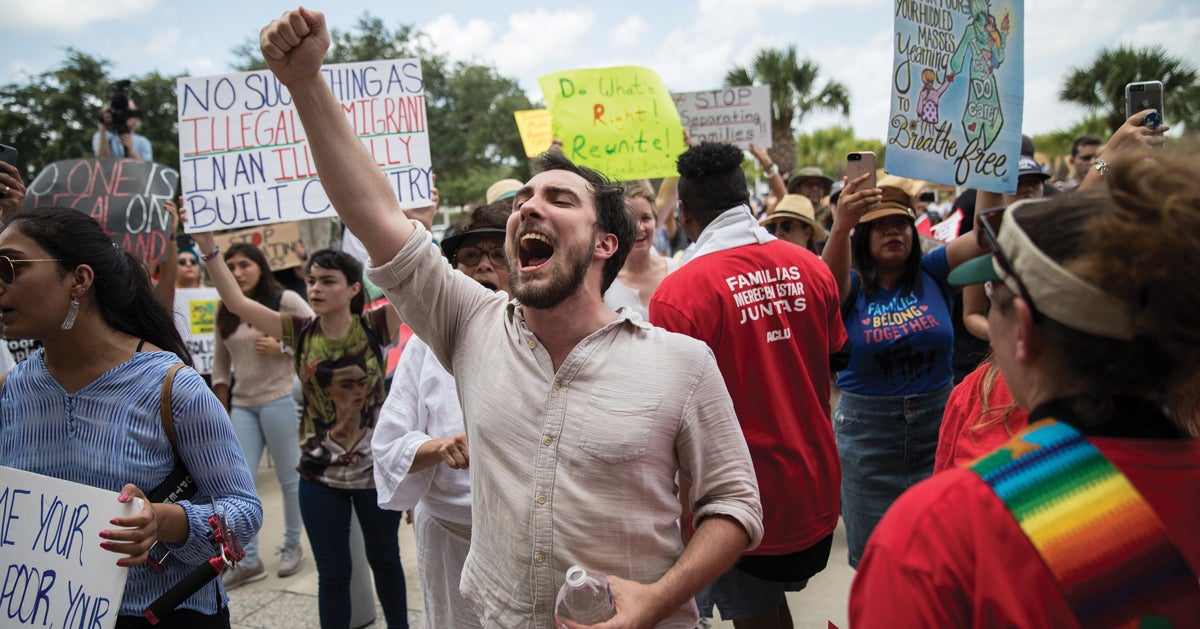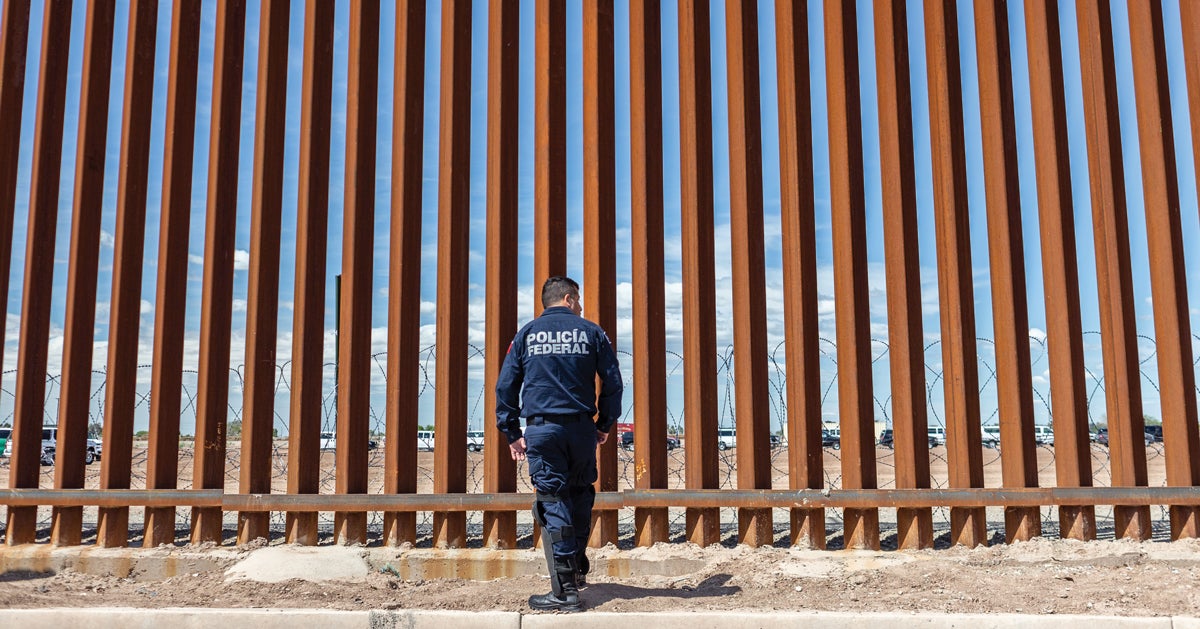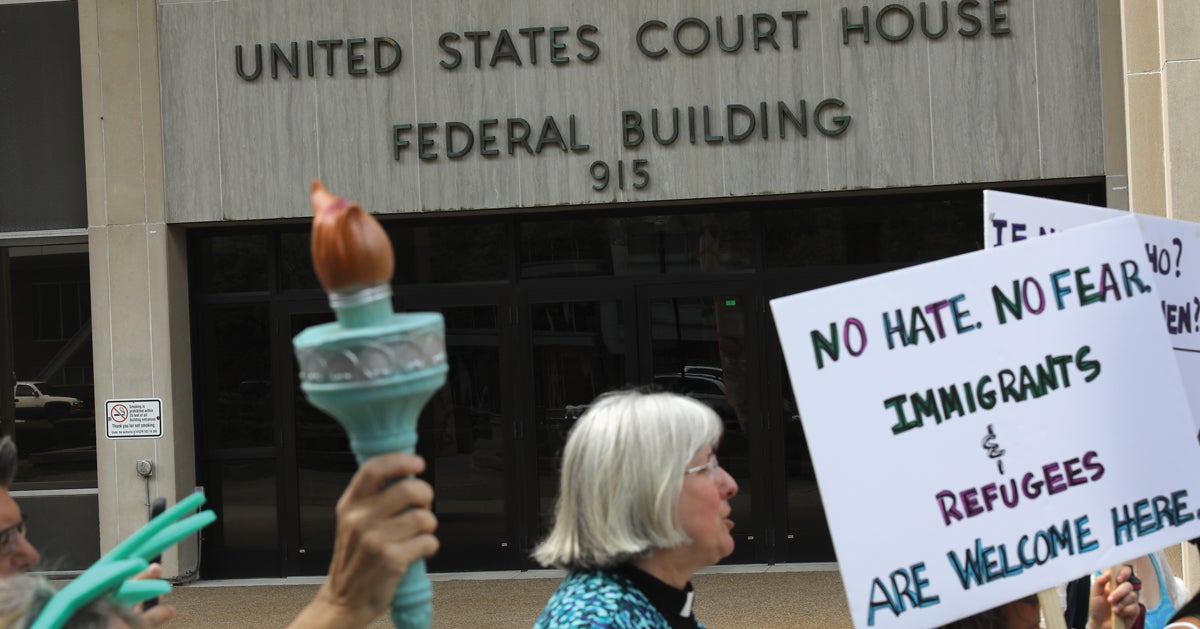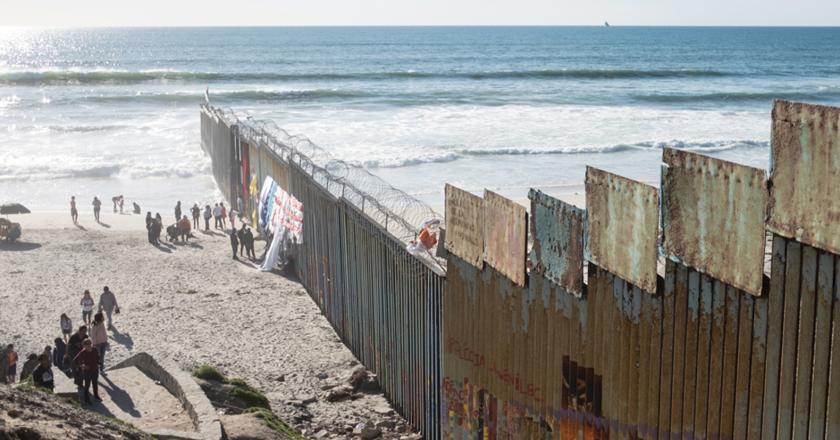Right now we are seeing a spike in illegal immigration at our southern border. Three things distinguish these immigrants from those who arrived previously. They are mostly: unaccompanied children or “family units” (i.e., adults with children); from Guatemala, Honduras, or El Salvador, rather than Mexico; and increasingly claiming, though not necessarily being granted, asylum.
Even though we are catching most of these aliens, we cannot remove them from the United States because of loopholes in our laws. We spend a lot of time talking about border barriers and other tools to secure the border, which do slow down border crossings and increase the chances of apprehension. But we don’t spend enough time talking about the fact that once an illegal immigrant enters the country and is apprehended, the immigration system generally just releases them into the United States.
Two loopholes plus our weak asylum system have created this catch-and-release system. The first is the well-intentioned Trafficking Victims Protection Reauthorization Act of 2008. The second is the ruling of the Court of Appeals for the Ninth Circuit in Flores v. Lynch (2016), which reinterpreted a 1997 settlement known as Flores. Because of these two loopholes if you show up at the border as an unaccompanied child or as an adult with a child, the United States is required by law to release the child and the family into the United States.
In 2018, the Trump administration began a policy of zero tolerance of illegal immigration, which resulted in detaining parents so their cases could be adjudicated, leading to, in most cases, deportation of the families. This policy became known as family separation. In response to intense political furor over family separation, the administration reversed the policy after only a couple months. So right now, family units showing up at our southern border are caught and then released. Many will fail to show up for their immigration court hearing, yet keeping the family together in custody is simply not allowed by law.
Our asylum system contributes to this mess by ensuring that very weak claims of “credible fear” are used to delay the adjudication of these cases, guaranteeing that the claimants will be released into the United States.
The result is the surge we are now seeing at our borders with children used as pawns to game the system. And because of the special attention and legal processes we give to children and asylum seekers, our immigration officials and court system are underwater, with no hope of ever digging out. Without changes, most of these illegal immigrants will remain in the United States even though only about 10 percent of Central Americans will actual end up being given asylum.
These loopholes should be changed to allow us to keep families together, but quickly return them to their home countries. The asylum process should also be pushed away from our borders so that claims can be handled in Mexico or even in Central America. Anyone who refuses to make an asylum claim south of our border should not be allowed into the United States unless they meet a high threshold of evidence for asylum.
By making these and other fixes, the United States can more effectively deter illegal immigration.
Mr. Inserra is a policy analyst at The Heritage Foundation.
Jessica Vaughan
In fiscal year 2017, foreign visitors overstayed their legal entries about 700,000 times, with more than 400,000 of them failing to depart or acquire a legal status within eight months after the end of the fiscal year. Not only does this rampant disregard for our laws undermine the integrity of our immigration system, it is also a national security and public safety vulnerability, since we can’t know the motives of those who overstay.
Congress has been pressing for action for 25 years, but successive administrations have failed to address the problem. The first step was to implement an entry-exit system, and one important benefit is that we now have a better idea of who is overstaying and in what categories of entry.
Now the State Department must adjust and issue fewer visas to applicants in categories with poor compliance. Dozens of countries have overstay rates of more than 30 percent in the student and worker categories, but their citizens continue to get visas.
The proceedings for the average overstayer likely will take over eight years. One option is to require certain categories of visa holders to waive their rights to a court hearing as a condition of admission.
In addition, we need to end the practice of giving every short-term visa holder a default six-month duration of stay. Instead, the routine admission should be no more than 30 days, unless the traveler can show a credible reason for a longer stay. Similarly, the duration of stay for Mexicans using the much-abused Border Crossing Cards intended for shopping and quick visits should again be restricted to 72 hours.
Tweaks using executive authority will help, but the most effective way to deter overstays is to reduce the incentives and increase the risk of consequences. If overstayers cannot easily get a job, a driver’s license, and other benefits, there is little point to remaining illegally. Implementing mandatory use of E-Verify and discouraging sanctuary policies will help.
For those who will not be deterred, we need more effective enforcement. Unlike illegal border crossers, who often can be processed administratively by immigration officers upon arrest, visa overstayers are entitled to more generous forms of due process, including a hearing in immigration court and the opportunity for protracted appeals. Our immigration courts are now so dysfunctional that the proceedings for the average overstayer arrested today likely will take over eight years. Congress should address the backlog; one option is to require certain categories of visa holders to waive their rights to a court hearing as a condition of admission, as is the case for those entering under the Visa Waiver Program.
In addition, visa sponsors—employers, exchange programs, schools, and labor brokers—who routinely fail to meet standards for participants’ compliance should be barred from sponsoring future visa applicants.
The travel sector, certain employer groups, and the education industry have been lobbying the president and Congress to issue more visas for students and guest workers, expand visa waivers, and back off reforms to exchange programs. It is irresponsible to even consider such proposals until overstays are greatly reduced.
Ms. Vaughan is director of policy studies at the Center for Immigration Studies.
David Bier
Congress should replace America’s current static immigration system with a dynamic one. During the last three decades, America’s population has grown by a third, and its economy has doubled in size. The share of U.S workers in the labor force with a college degree has doubled, while the share without a high school degree has halved. About three quarters of the Fortune 500’s largest companies were replaced, while entire new industries—the Tech Economy, the Internet Economy, and the Gig Economy—have come to life. Despite these vast changes, Congress has failed to update America’s legal immigration system.
Congress should remove immigration caps entirely for the highest skilled categories—stop making Einsteins wait for permanent residence.
The last legal immigration overhaul came in 1990. Congress increased the caps for family- and employer-sponsored immigrants and created a couple of new categories for green card applicants, such as one for investors. But since then, the numbers have remained stuck. The result is an antiquated immigration system out of touch with the U.S. economy and society. Huge backlogs of applicants waiting for green cards have developed, causing average waits to double. Many immigrants now wait a decade or even multiple decades to receive legal permanent residence. A slow cumbersome process simply doesn’t work for an advanced economy and stands as an advertisement for illegal immigration.
If Congress does break its logjam on immigration, it should construct a system that is responsive to changes in the economy and society, making constant updates unnecessary. It should remove immigration caps entirely for the highest skilled categories—stop making Einsteins wait for permanent residence. For the remaining caps, Congress should first update them to reflect the changes since 1990, and then going forward, it should link the family- and employer-sponsored limits to population growth and economic growth, respectively. That way as the number of families in the United States increases, the green card quotas for families increases proportionally, and as economic growth accelerates, businesses can hire more foreign workers.
Congress cannot predict the exact types of workers or numbers that a future economy will need. But it can predict with certainty that the world will not stand still. It needs to make sure the immigration system keeps up with the world around it. This simple reform would prevent the immigration system from becoming outdated almost as soon as a new law is enacted.
Mr. Bier is a policy analyst for the Cato Institute.
 Protestors rally against zero-tolerance immigration policies at Brownsville, Texas, June 28, 2018. credit: Tamir Kalifa/Getty Images
Protestors rally against zero-tolerance immigration policies at Brownsville, Texas, June 28, 2018. credit: Tamir Kalifa/Getty Images
Andrew Arthur
One simple change would eliminate most if not all of the challenges facing the U.S. immigration system: mandating that employers use the E-Verify process to ensure that employees are eligible to work in the United States.
The Department of Homeland Security (DHS) explains the process on its website:
In the E-Verify process, employers create cases based on information taken from an employee’s Form I-9, Employment Eligibility Verification. E-Verify then electronically compares that information to records available to [DHS] and the Social Security Administration (SSA). The employer usually receives a response within a few seconds either confirming the employee’s employment eligibility or indicating that the employee needs to take further action to complete the case.
During my eight years as an immigration judge, I heard approximately 15,000 cases. By my rough estimate, at least 98 percent of those aliens came to the United States to work.
The decision to enter the United States illegally or to overstay a visa for such individuals is a simple economic one: Will I make enough money in the United States to pay the smuggler or the other fees what it cost to get here? E-Verify will effectively deny most of those individuals the opportunity to work in this country. By turning off the “jobs magnet” that lures those foreign nationals to this country, that flow of migrants stops.
The other problems facing the U.S. immigration system would become manageable. The caseload facing our 400 immigration judges currently stands at about 856,000; that backlog could slowly be whittled down if the flow of illegal workers was stymied.
Then, U.S. Immigration and Customs Enforcement (ICE) would no longer have to devote as many resources to apprehending illegal aliens. With the proliferation of so-called “sanctuary jurisdictions” (which refuse to cooperate with immigration enforcement), ICE must routinely send officers into the field to apprehend visa overstayers—a necessity that endangers both ICE officers and the public.
E-Verify implementation would slash the number of aliens entering illegally, allowing our 18,600 Border Patrol agents to focus more resources on drug and contraband smuggling, and fewer on aliens slipping across the border.
 An officer of the Mexican Federal Police stands next to the US-Mexico Border Fence on April 5 in Mexicali, Mexico. credit: Luis Boza/VIEWpress/Corbis via Getty Images
An officer of the Mexican Federal Police stands next to the US-Mexico Border Fence on April 5 in Mexicali, Mexico. credit: Luis Boza/VIEWpress/Corbis via Getty Images
E-Verify would not be a silver bullet. Loopholes in our border laws would still encourage families with children and unaccompanied alien minors to enter the United States illegally, straining Border Patrol resources.
Aliens who manage to evade detection at the border or overstay could still apply with one of our approximately 520 asylum officers for “affirmative asylum.” Such an application carries the possibility of an employment authorization document (EAD) to even those with non-meritorious claims to work in the United States if their bogus claims cannot be adjudicated within 180 days.
Mandating E-Verify would nonetheless make the work of our immigration officials significantly easier. The president can implement that policy by executive order. He should.
Mr. Arthur is a resident fellow in law and policy at the Center for Immigration Studies.
 Protestors rally against zero-tolerance immigration policies in Bridgeport, Conn., July 11, 2018. credit: Ohn Moore/Getty Images
Protestors rally against zero-tolerance immigration policies in Bridgeport, Conn., July 11, 2018. credit: Ohn Moore/Getty Images
While Article I, Section 8 of the Constitution gives Congress exclusive authority over immigration, there is a great deal that state and local governments can do in this area. In fact, their assistance and the resources they can bring to bear on the problem are vital to the United States having a comprehensive, efficient enforcement system to prevent illegal immigration.
State governments should prohibit local governments from implementing any policies that prevent local law enforcement from notifying, assisting, or cooperating with federal immigration authorities.
Implementing sanctuary policies are the exact opposite of what local governments should do. In fact, local law enforcement should be acting as advance scouts for federal authorities. When aliens are arrested for committing local crimes, it is in the best interests of local communities and public safety for the federal government to be notified so these criminal aliens can be picked up by federal authorities and removed from the country, either after they have been arrested or detained or after they have served their sentences.
State governments should prohibit local governments from implementing any policies that prevent local law enforcement from notifying, assisting, or cooperating with federal immigration authorities; instead, state governments should require such assistance by local communities. In 2012, in Arizona v. U.S., the U.S. Supreme Court upheld Arizona’s requirement that law enforcement officials check the immigration status of anyone they arrest, stop, or detain if they have a reasonable suspicion the individual is an illegal alien.
States should not provide driver’s licenses to illegal aliens, nor should they allow illegal aliens to obtain license tags for their automobiles. Illegal aliens should be banned from obtaining professional licenses of any kind, and they should not be eligible for any state or local benefits such as public assistance or in-state tuition. In fact, federal law (which, unfortunately, has not been enforced) prohibits state universities from providing in-state tuition to illegal aliens unless the same in-state tuition is offered to all students who are citizens. There should be no financial or other incentives of any kind that provide illegal aliens with a reason to come to, or remain in, the United States.
The vast majority of illegal aliens come here for economic reasons—to earn money to send back to their families in their native countries. To protect American workers and reduce this economic incentive, the federal government requires employers to check the citizenship or legal immigration status of all new employees to prevent illegal aliens from obtaining employment. It also provides the federal E-Verify system that employers can voluntarily use to comply with this requirement.
In 2011 in Chamber of Commerce v. Whiting, the U.S. Supreme Court upheld an Arizona statute that made use of the federal E-Verify system by Arizona employers mandatory. The state statute imposes a series of penalties on employers who knowingly or intentionally employ illegal aliens, including suspension or revocation of the employers’ business license. This is a key method for ensuring that illegal aliens are not unlawfully employed, which reduces their economic incentive to remain in the country.
Mr. von Spakovsky is senior legal fellow at The Heritage Foundation.
